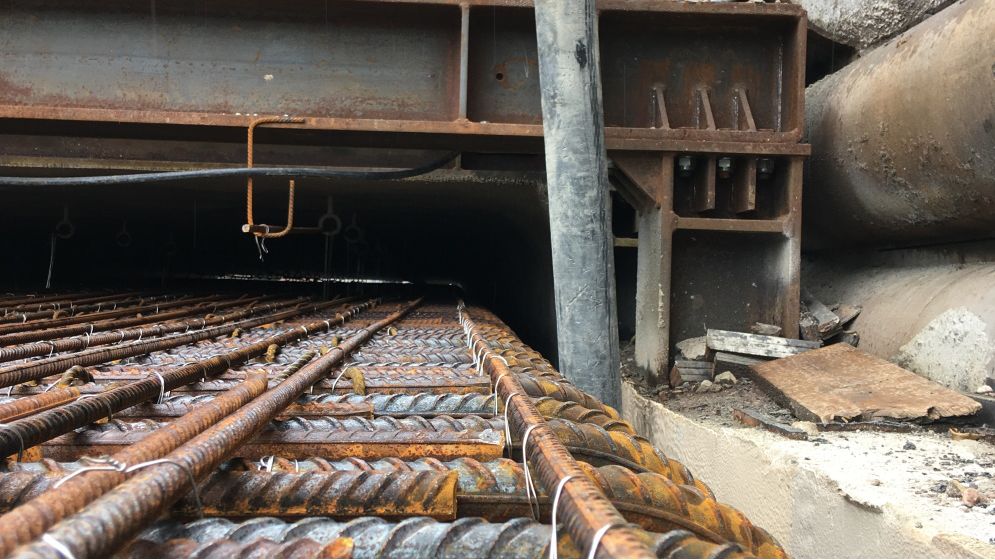2019
St Helens, United Kingdom
Newton-le-Willows train station, located just outside St Helens, is part of the original Liverpool and Manchester Railway Line, the birthplace of the modern commuter railway which opened in 1830*.
A multi-million pound* scheme to renovate the station was completed earlier this year, offering 21st Century solutions to an increase in commuter numbers, such as a new subway, stairs, lifts, ticket office and waiting room.
Galliford Try was contracted by Network Rail to deliver the rail elements of the project, including a subway, which was to be constructed underneath the existing live track. The finished subway would provide a faster pedestrian route between platforms. This was complicated by operator requirements that train schedules should not be affected throughout the duration of works.
Galliford Try consulted heavy building materials supplier Hanson UK on the requirements for the subway in order to deliver this complex project on time and to budget, whilst keeping interference and disruption to a minimum.
Project Requirements
A tunnel underneath the live track, which would eventually become the subway, was carved out in Q3 2018 and supported with steel strut reinforcements, each approximately 30m in length. These needed to be kept in place in order to redistribute the weight of trains passing overhead and ensure the structural stability of the newly-created subway.
Plans initially allowed for 114.5m3 of Portland cement-based concrete to form the subway’s interior façade and permanently stabilise the structure.
However, the steel struts, which had initially been crucial to delivering the project with minimal disruption to rail users, now presented a major logistical challenge.
Mechanically vibrating the concrete once it’s been poured into the tunnel cavity is the traditional approach to such a project, ridding the freshly-formed material of any trapped air that might shorten its lifespan.
In this instance, however, the struts proved an obstacle and accessibility challenge to the heavy machinery required for carrying this out.
As no way forward could be found that wouldn’t involve closing the station to rail traffic for a period of time, Hanson UK enlisted concrete admixture specialist Sika to find a creative solution to the issue.
Sika Solutions
Sika’s ViscoFlow® admixture, which converts Portland-cement based concrete into SCC, was added to the material earmarked for the tunnel’s interior walls.
Meanwhile, a combination of Sika ViscoFlow® and Sika Watertight Concrete Powder were added to the 101m3 of concrete required for the tunnel’s internal roof.
“We wanted to ensure that the tunnel roof was watertight, because of the risk of rainwater seepage”, explains Peter. “Our ViscoFlow® and Sika Watertight Concrete Powder admixtures are completely compatible and do not affect each other’s performance.
“On the contrary, waterproofing SCC reduces the risk of a lack of compaction, which can cause long-term issues if not addressed correctly.”
The tunnel interior was sealed with SCC over the course of a month between August and September 2018, with concrete being poured in seven instalments as the sections of steel struts were installed. Traditional mechanical compacting could have taken up to three times longer.
The tunnel, along with the other customer-friendly features at the revamped station, opened on time and to budget in January 2019*.
* Mersey Travel – https://www.merseytravel.gov.uk/about-us/media-centre/news/Pages/New-and-improved-facilities-at-Newton-le-Willows-station-set-for-opening-this-weekend.aspx
"Laying self-compacting concrete is done with ease due to its high fluidity, as opposed to conventional concrete slump workability. Typically it is used in circumstances where the noise generated by mechanically vibrating concrete would be prohibitive, such as inner city apartment block projects. We saw a clear opportunity to utilise it to its full effect in this case, however. Self-compacting concrete (SCC) also cuts down on the manpower required to screed a freshly-concreted area – a team of up to six can be needed when doing this the mechanical way, but admixtures such as Sika’s ViscoFlow® negate this demand on time and human resources. SCC is uniquely flexible to design requirements, owing to its ability to replicate the formwork of the surfaces it is applied to, with minimal interference. I do not believe there was any other way that the project at Newton-le-Willows station could have been delivered without significant disruption." Peter Cowan, of Sika Concrete and Waterproofing
Download Case Study
Brochures
Product Used
Sika ViscoFlow®
Sika® Watertight Concrete
Self-Compacting Concrete

